Introduction
The New Year starts with the Yahoo Japan Auctions clearly still nursing a hangover from the celebrations earlier in the week, and we are nowhere near back to normal with regards to the number of listings. However, what we lack in quantity, we certainly can make up for in quality of listings for me to pick out and discuss!
One thing I would like to share with you all this week (especially since, as this is the first newsletter of the month, it is being sent out to all subscribers, and heck - since it’s the first newsletter of the year, I’ll even remove the paywall completely just this once) is that I have started a second Substack.
Watchdxb will effectively be a continuation of my Instagram account (which will now solely be used to promote content ‘over here’), so if you followed me ‘over there’ and enjoyed the watch videos and other horological meanderings, Substack is where you will find the content in the future.
The watchdxb Substack will also be where I will be offering non-vintage Grand Seiko’s from my rather-too-large watch collection for sale, and the ‘stack kicks off with an absolute blinder - an example of Seiko’s legendary Astronomical Observatory Chronometer.
More details about the plans for the watchdxb Substack can be found on the “about” page, here.
Ok that’s enough cross-promotion for now, let’s take a look behind the filing cabinet and see what goodies we can find up for auction this week!
Dalton Russell
The first Grand Seiko with raised logo dial
I noticed this auction when it was listed last night and added it to my watchlist, and was rather surprised to wake up in the morning and find that it had somehow garnered 97 bids overnight!
Looks like there was some automated bidding to push the price up to 100,000 Yen and get it noticed, which is all well and good, but that kind of practice does make one a little wary.
Regardless of any strategy deployed to get the attention of the Yahoo Japan Auction algorithm, barring one rather significant flaw, the watch looks to be a lovely example of the first Grand Seiko dating from September 1961.
As is only to be expected with examples of this reference, the dial shows light spotting all over, but crucially there do not appear to be any additional significant dial blemishes such as scratches or stains.
Obviously you’ll be wanting to get that crystal replaced, but it’s good to see that for once an example of the first Grand Seiko turning up with what is its original crown.
The wear on the crown shows that this is a watch that has had a lot of wrist time in the 60+ years since it was produced, but clearly from the state of the case it has not had a great deal of cleaning - no doubt it would come out from an ultrasonic bathe looking a lot better than it does here!
The only real downside is the lion medallion on the casback, of which to say it had seen better days would be the understatement of the year so far!
Quite how a medallion ends up in that state I have no idea, but it will I’m sure be sufficient to turn a lot of people off. At the end of the day, it’s not something that anyone is going to be able to see when the watch is on your wrist, so I suppose you could keep it as your little secret!
If you do decide to bid on this one, do keep an eye out for any suspicious bidding practices at the close of the auction, and don’t get too carried away.
Grand Seiko 4420-9990
It’s pretty rare for an example of the cap gold cased 44GS to turn up looking as nice as this one does. Yes the case has clearly had some gentle polishing over the years, but the dial is almost spotless, with just a slight chip under the applied Seiko, and a couple of very minor stains - most notably the one at the 36 minute tick - to call out.
These are easily overlooked by collectors who of course typically would gravitate towards the steel cased references, but they are great watches, and have that wonderful (and unique across the entire vintage Grand Seiko range) second hand.
Grand Seiko 43999 SD dial
Not the greatest example you could hope to find, but the SD dialed 43999 is of course highly sought after so when an honest one turns up from a reputable seller, it’s always worth a mention.
The biggest downside here is - as regular readers will by now be well aware of - the incorrect later “fine knurled” crown. For me, an original coarse knurled crown is absolutely essential on one of these, so if you are going to be bidding on this one, you might want to consider the effort and cost it might take to ‘fix’ the crown issue.
Or maybe it’s just not important to you, and you’re happy with the crown as it is - afterall, when Seiko would have serviced this watch back in the day, they themselves would have replaced any original worn down crowns with what you see here, so maybe I’m being a little to harsh on it!
Grand Seiko 5646-7010 blue dial
From the photos provided here we can clearly see that this watch has had its fair share of scrapes over the years, but the case remains very sharp so it seems that whoever was knocking it about chose not to have the scratches “attended to”.
The biggest turn-off here will be the scratched up crystal, that you will definitely want to get replaced, but the great thing about the 564x-7010’s is that they were made in vast numbers and replacement crystals - either third party or original - are not too difficult to track down. The part number is 300V16GN. Budget $40 or so for a third party crystal, and perhaps double that for an original sealed dead stock example from Seiko themselves.
The seller does state that the watch is working, but doesn’t specifically mention the day/date mechanism, which as most know is prone to failure on the 5646 movement due to the use of a plastic cog. Work on the assumption that will need fixing, and treat it as a bonus if the mechanism turns out to be fully functional.
So yes, a bit of a mini-project here for someone, but the blue dialed 564x-7010’s are always in high demand, so ones like these are worth the effort if you’re not prepared to shell out what is needed to acquire a minty one.
Grand Seiko 4520-8000
Just a lovely clean and honest example of what many would consider to be the ideal one watch vintage Grand Seiko “collection”. Almost all the benefits of the Grammar of Design details of the 44GS, with the 4520A 36000bph movement thrown in for the better.
And remember - the very same 4520A movement in this watch can be found in the most accurate mechanical wristwatch Seiko have ever created, the Astronomical Observatory Chronometer. The movements for those watches were simply plucked from the regular production line and then passed over to the greatest regleurs in Seiko’s employ.
Theoretically, in the right hands and with sufficient love and attention, the movement here could pass the 45 day astronomical observatory chronometer test.
The dial has some slight signs of wear at the periphery between the 6 and 8 hour markers, but that’s about the only negative cosmetic thing to call out. The case is super sharp, although of course with signs of wear and tear, but nothing major to call out. Finally, the caseback medallion is in superb condition, though it has to be said it has clearly been re-seated at some point in its life, because it’s not quite straight.
As a bonus, the original and correct buckle is supplied with the watch.
If you only have space for one vintage Grand Seiko in your collection, and don’t have bottomless pockets, this may well be the one for you.
The first Grand Seiko with raised logo dial
This one makes for a very interesting comparison with the lead watch in this week’s newsletter.
Whilst it is undoubtedly much more professionally presented, and doesn’t suffer from the caseback medallion issues of the earlier watch, I think it does serve to demonstrate how just one relatively small dial issue can turn many people off a watch in an instant.
The dial of course has the same light overall spotting as the other one, but that glaring spot near the 1 o’clock index is a real eyesore, to the extent that one might not even notice the other lesser dial issues such as the staining between the 11 and 12 indices, and the marks between the 9 and 10 indices.
Oddly though, in recent times issues such as these don’t seem to be putting people off quite as much as I believe they used to in the past. Possibly it’s a sign that more and more people are looking to add a “First” to their collections, and so there is simply more demand overall.
Personally I’d take the earlier featured watch with the mauled medallion over one with a dial like this every single time. It will be interesting to see what “the market” says when we find out the closing prices for the two auctions.
Grand Seiko 6185-8021 VFA
Lovely bit of woven fabric there, but please please please - any chance we can see just a little more of the watch? Sadly it seems on clicking through the remaining photos, the answer is a resounding “nope”.
Don’t know about you, but I’d rather have much higher resolution images (or a video!) when considering purchasing a VFA. So much could be hidden here, although even from these photos it does look as though there are some issues around the dial periphery -
- and we can see some dings in the case in the profile shot -
Also it must be said there is a lot unseen here, so don’t think that I am by any means highlighting every issue that might be there.
Caveat emptor, and good luck!
It’s not a vintage Grand Seiko, but I love it
Seiko Astronomical Observatory Chronometer
Shameless plug time. It’s not a vintage Grand Seiko, but it’s oh-so-close to being one. Go check it out, and don’t forget to sign up for more (much more) content to come!
Arthur Case
Grand Seiko 6146-8020
Whilst almost all original blue dial variants of the 614x-8020’s will have lost their saturation over the decades and had their dials turn to a deep grey or charcoal colour, they don’t go jet black like the one seen here.
Here’s how they should look -
So what we have here is a complete redial, and as is so often the case, despite the relatively high quality of the reprint, there is a clear ‘tell’ in the pointy A’s in the dial code at the bottom of the dial -
Definitely one to avoid.
Grand Seiko 4522-7010/King Seiko hybrid
Clearly something obviously wrong with this one, but possibly it might be worth keeping an eye on should you want to pick up a 45GS movement for spares!
Grand Seiko 6156-8040/6146-8050 Frankenstein
Not entirely sure what would have motivated someone to hack this together, although the seller does come up with something akin to an explanation.
It gets worse though, because the caseback medallion is missing, and the claimed “original belt” is certainly not correct since the XQB220 bracelet for the 6156-8040 should have its part number stamped on the endlinks.
The only unresolved question for those looking at this and considering it for breaking down for spare parts, is what is the movement inside? Based on the description of the history of the watch (and the fact the seller states that the calendar can be quickset), it is probable that is indeed a 6156 rather than a 6146, but would you really want to take a punt on it?
Grand Seiko 6246-9000
Whilst there is nothing really “wrong” here - certainly the watch is all original - I thought I’d include this listing because there are a few aspects that are worth highlighting that you should look out for if you’re after an example of Grand Seiko’s first automatic watch.
The case retains its overall lines fairly well, but it has clearly been polished. There are always a number of things to look out for when considering whether or not a case has been polished, and they can be highlighted here quite easily.
The first place people tend to check is the lugs, and whilst the polishing is relatively gentle has been done somewhat respectfully, there’s no getting away from the fact that they have softened up somewhat.
That highlighted corner where the three surfaces meet is the most obvious thing to look out for. I must stress that this is pretty minor polishing here - the watch will still look great on the wrist.
The other thing to look out for is one that didn’t actually occur to me until relatively recently, and that’s to actually look at any dings and scratches.
The problem with trying to assess a case from the state of its corners and edges is that lighting can play a big part in either hiding polishing that has been done, or making you think something has been polished when quite possibly it hasn’t.
But when we take a look at blemishes on the a case surface, it is immediately obvious whether or not the case has been polished after it has been scratched or marked - the scratches and marks themselves will have soft edges.
The second aspect of this watch that is worth highlighting is the quality of the print on the dial.
I’m not entirely sure how something like this can happen, but there is certainly some “bleeding” of the print - something that ideally one would want to avoid.
Note also that there are some obvious stains around the dial periphery, such as the one seen here at the 17 minute marker -
Finally (and I double checked the parallax provided by two different images to make sure this really was an issue with the index), the indices on this watch have somehow ended up degraded and the spotting, whatever might have caused it, is very obvious -
I chose to highlight this one because in pretty much every detail that you would want to aesthetically examine in a watch, we find issues to reject it, even though at first glance the watch appeared to be an OK example of the reference. It is particularly odd, because usually the dials and dial furniture on the 62GS references age particularly well.
For reference, here is an example of how we would prefer to find them -
Grand Seiko 6246-9001
Closing this week with a second example of a 62GS, this time the slightly later 6246-9001 with the GS logo medallion rather than the lion medallion found on the -9000’s.
Case wise, this one seems to be a more desirable proposition, as those scratches don’t look to have had much of an attempt to polish them out. But, the photography could well be hiding all sorts of issues here as once again we have a listing where the resolution just isn’t high enough to make a confident decision on the condition.
At least the dial on this one looks to be in much better condition - no smudging of the print, and the indices would appear to be in great condition.
There are two glaring issues with the dial though - just take a look at the applied Seiko and GS logo.
The watch is actually on a buy it now of “just” 110,000 Yen, which honestly I think is actually a very fair price, even given the applied logo issues. What is rather odd though is that someone has seen fit to meet the original minimum bid price of 100,000 Yen.
Really? So you’re happy to bid 100k, and hope to win the watch, but you won’t just spend that little extra 10% to acquire it for sure?
Hmmm…
Redone coloured dial summary
I close with the usual reminder to steer clear of any vintage Grand Seikos with coloured dials similar to the above. This is not a comprehensive photo - there are many references that get this “treatment”, so be careful out there.





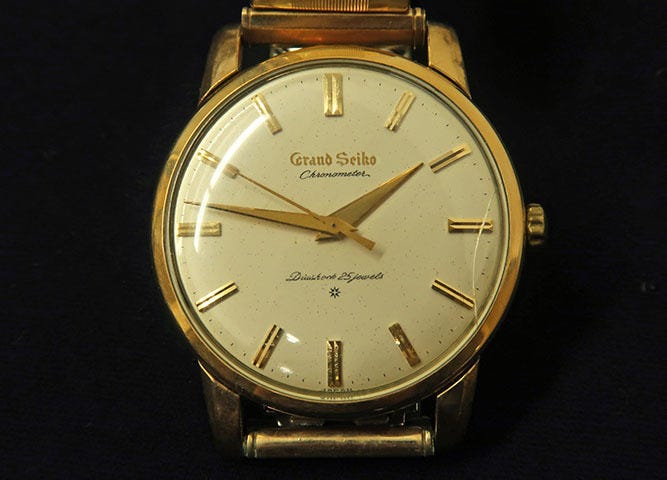


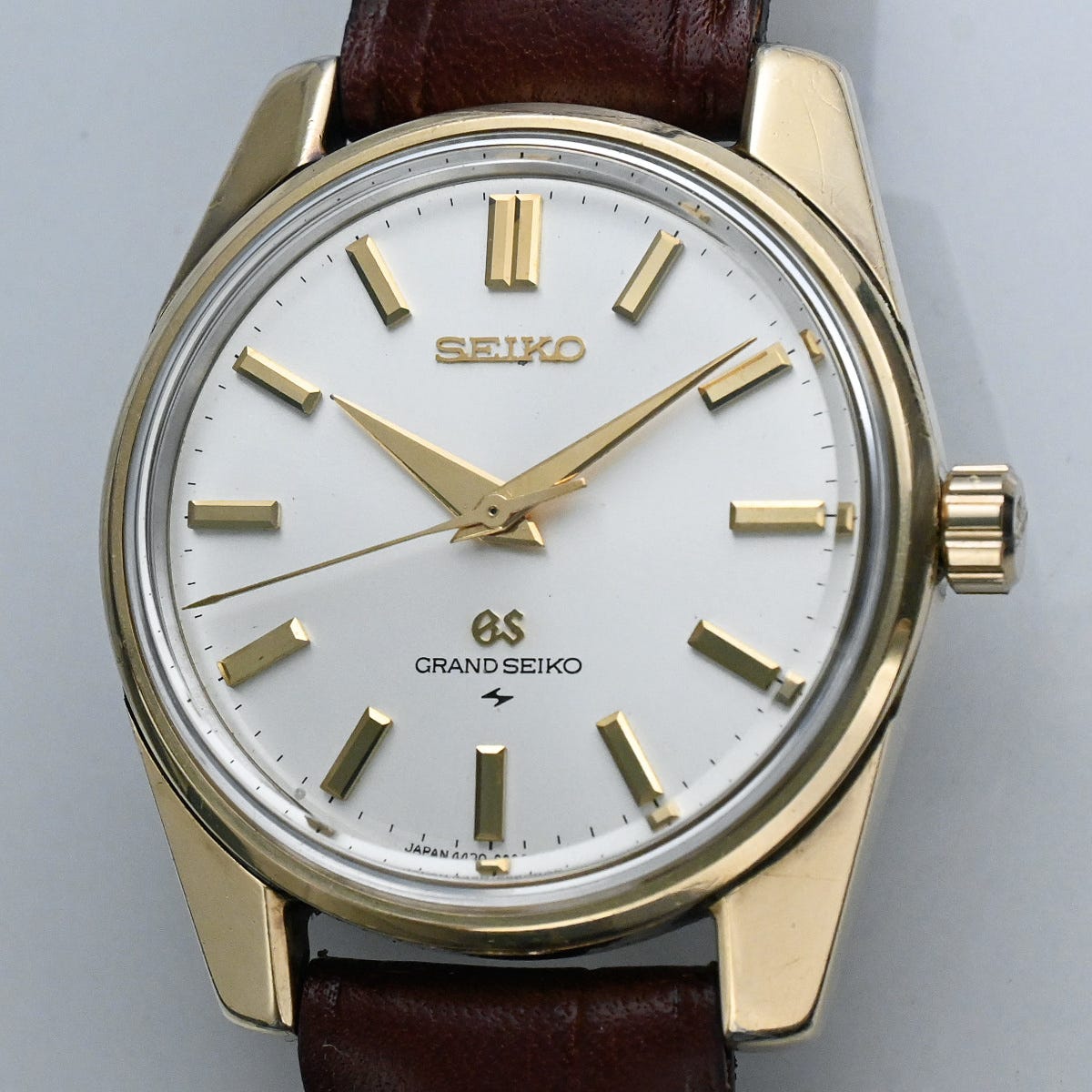
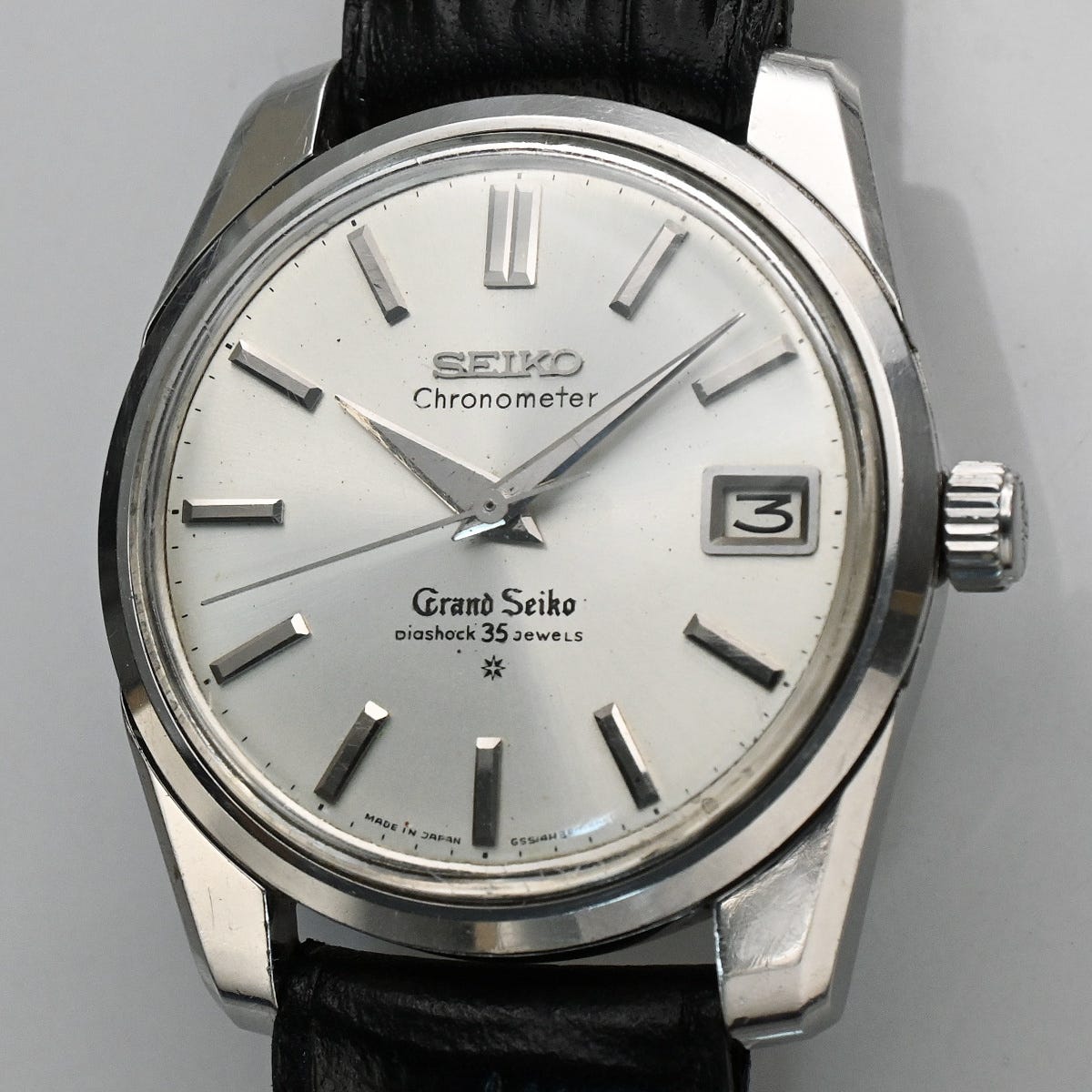
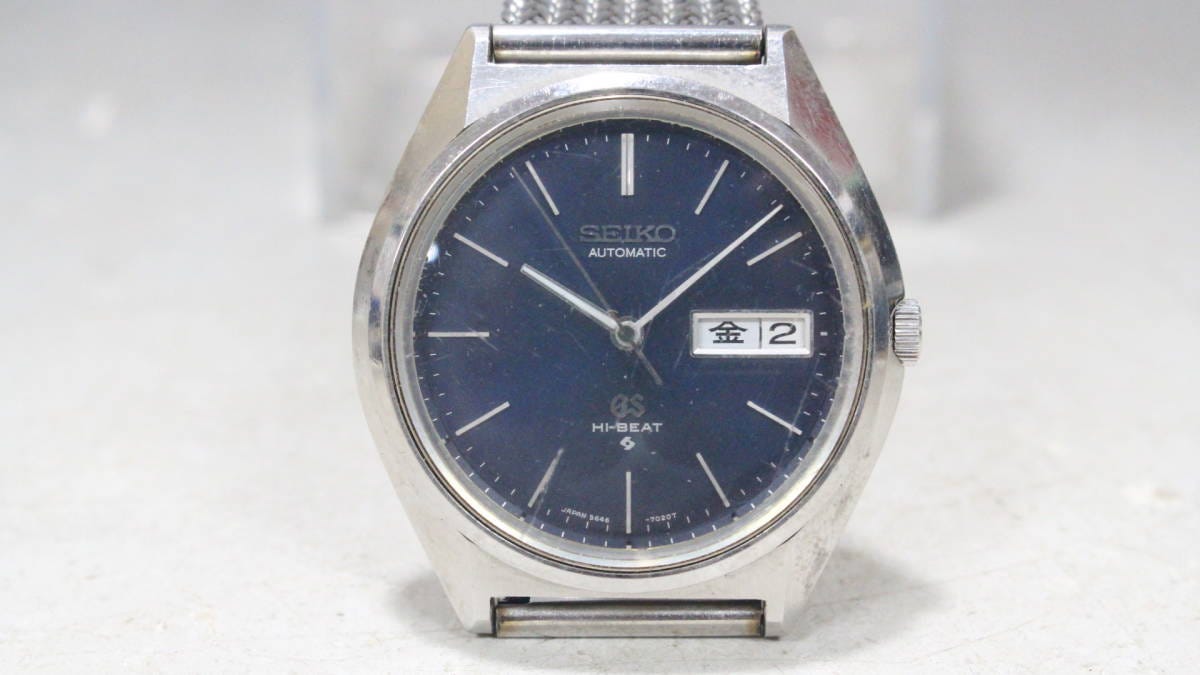
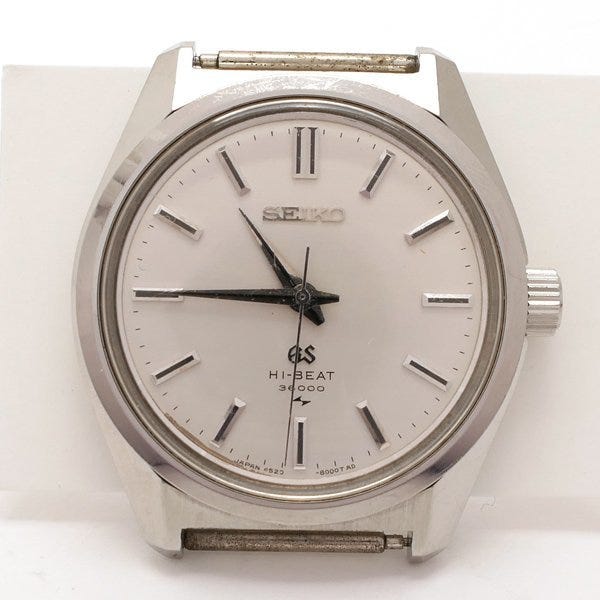

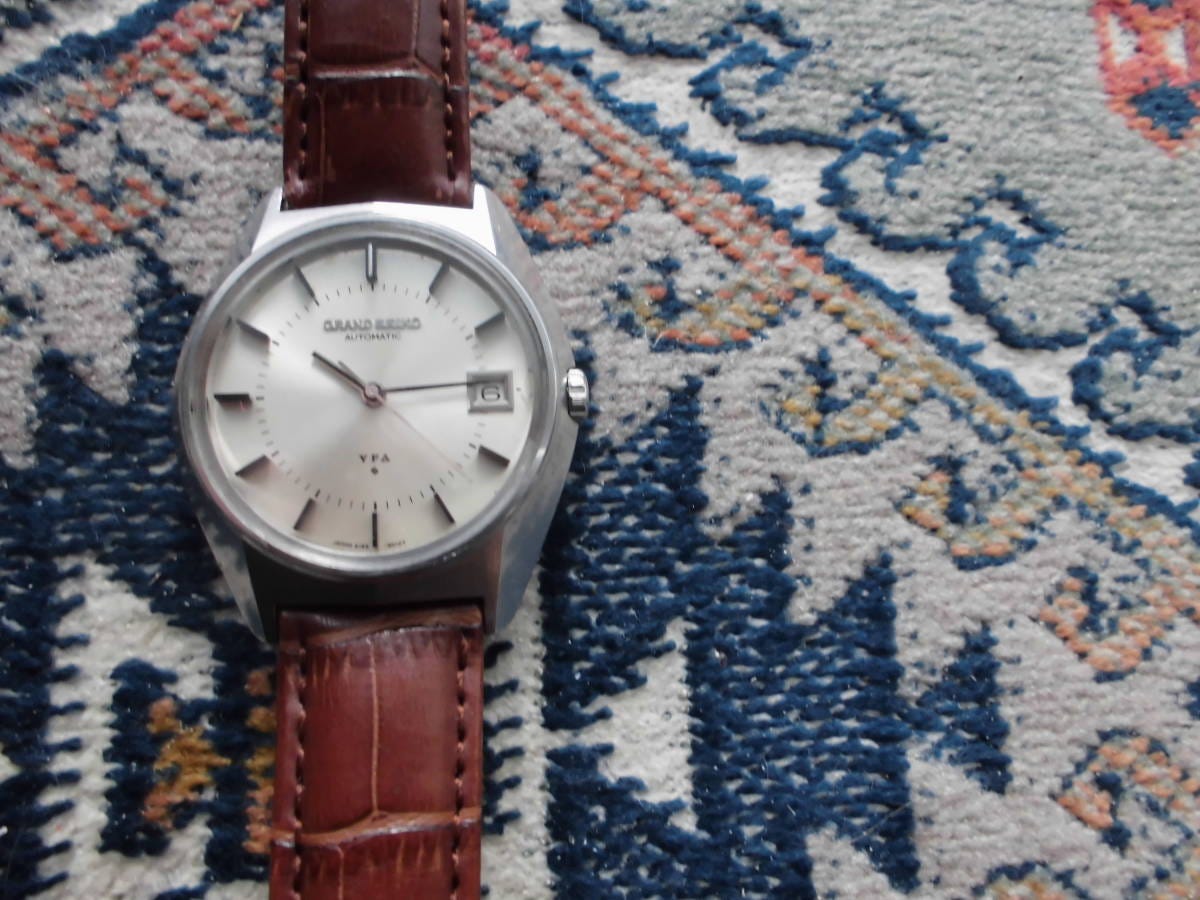




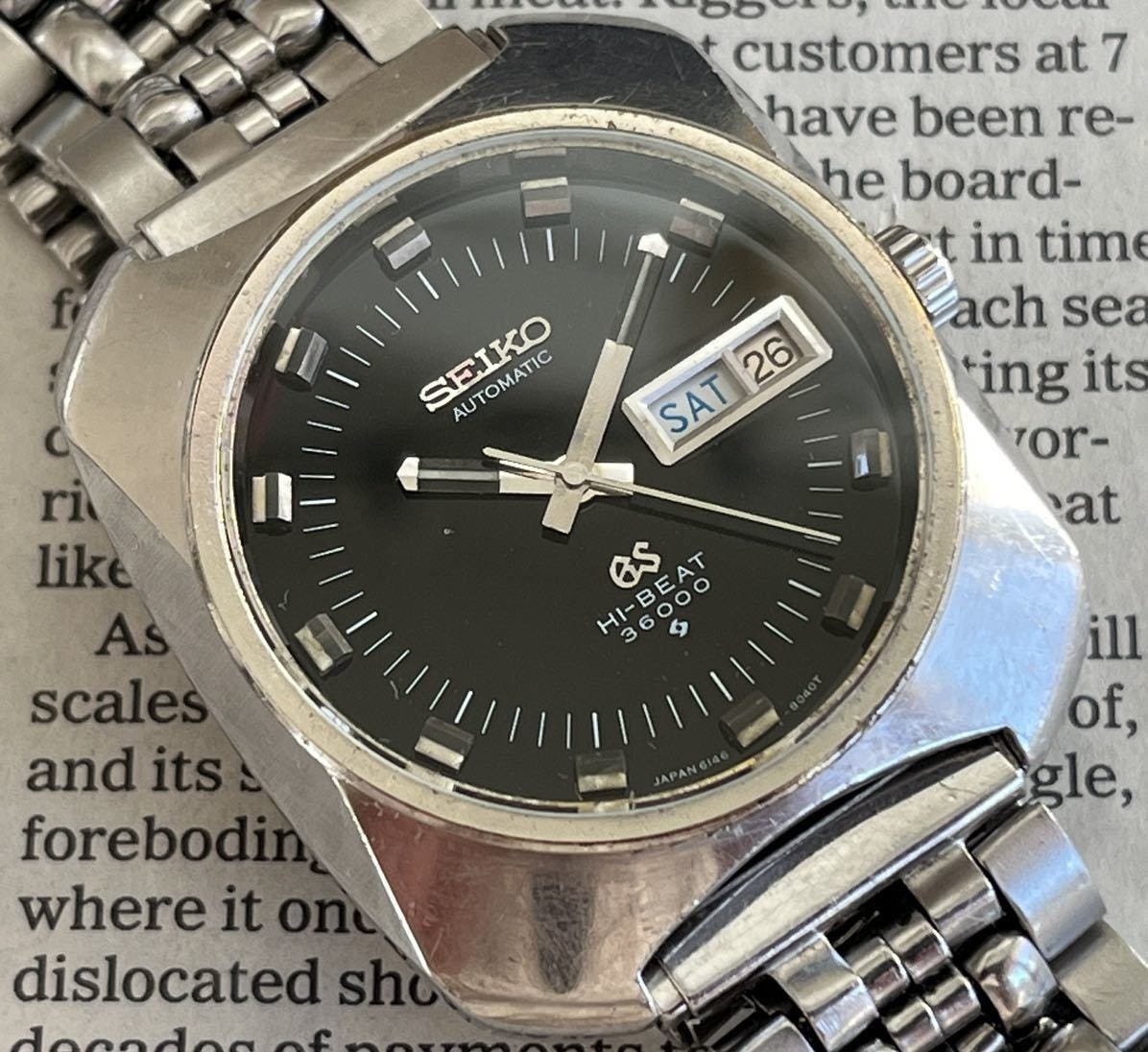
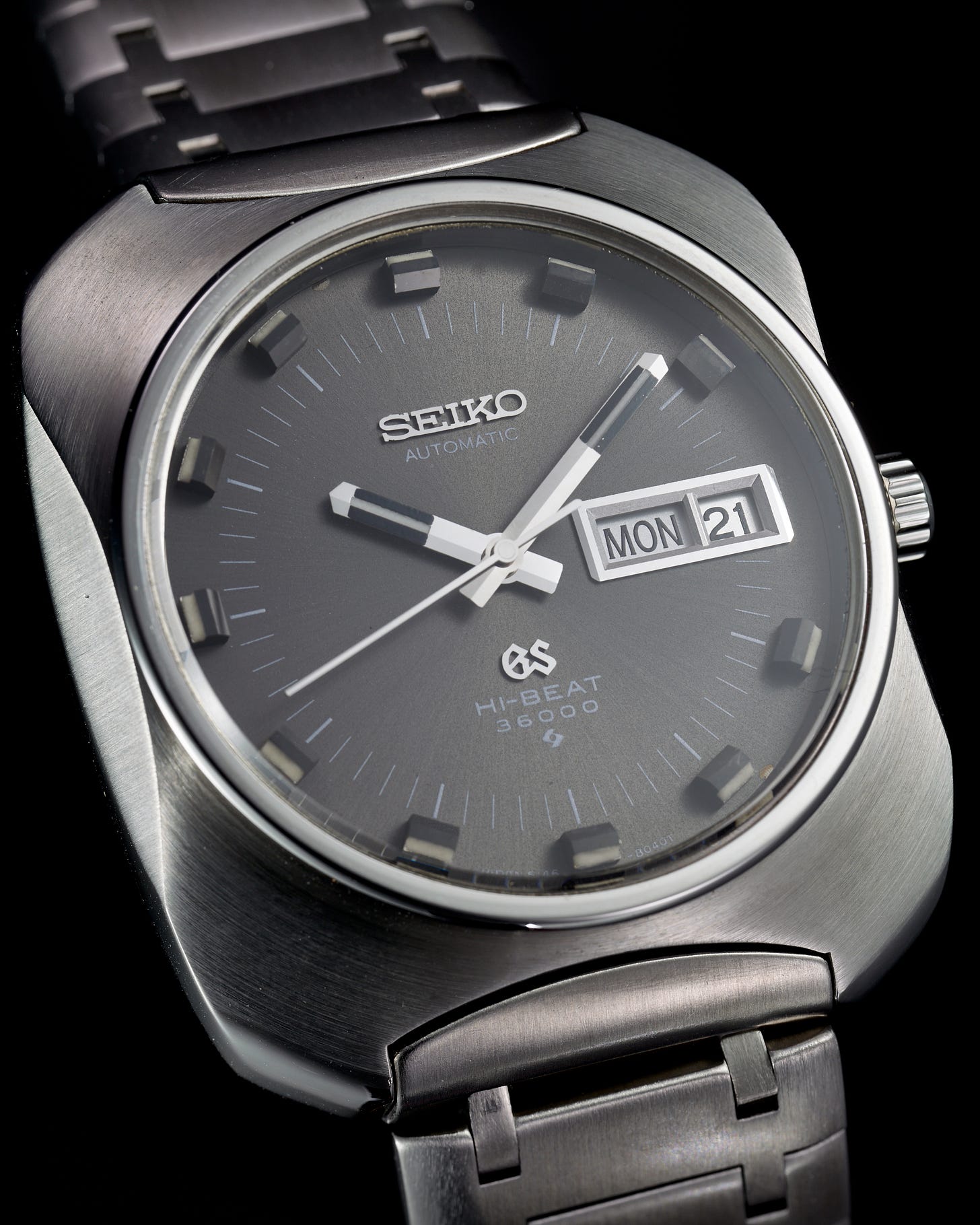

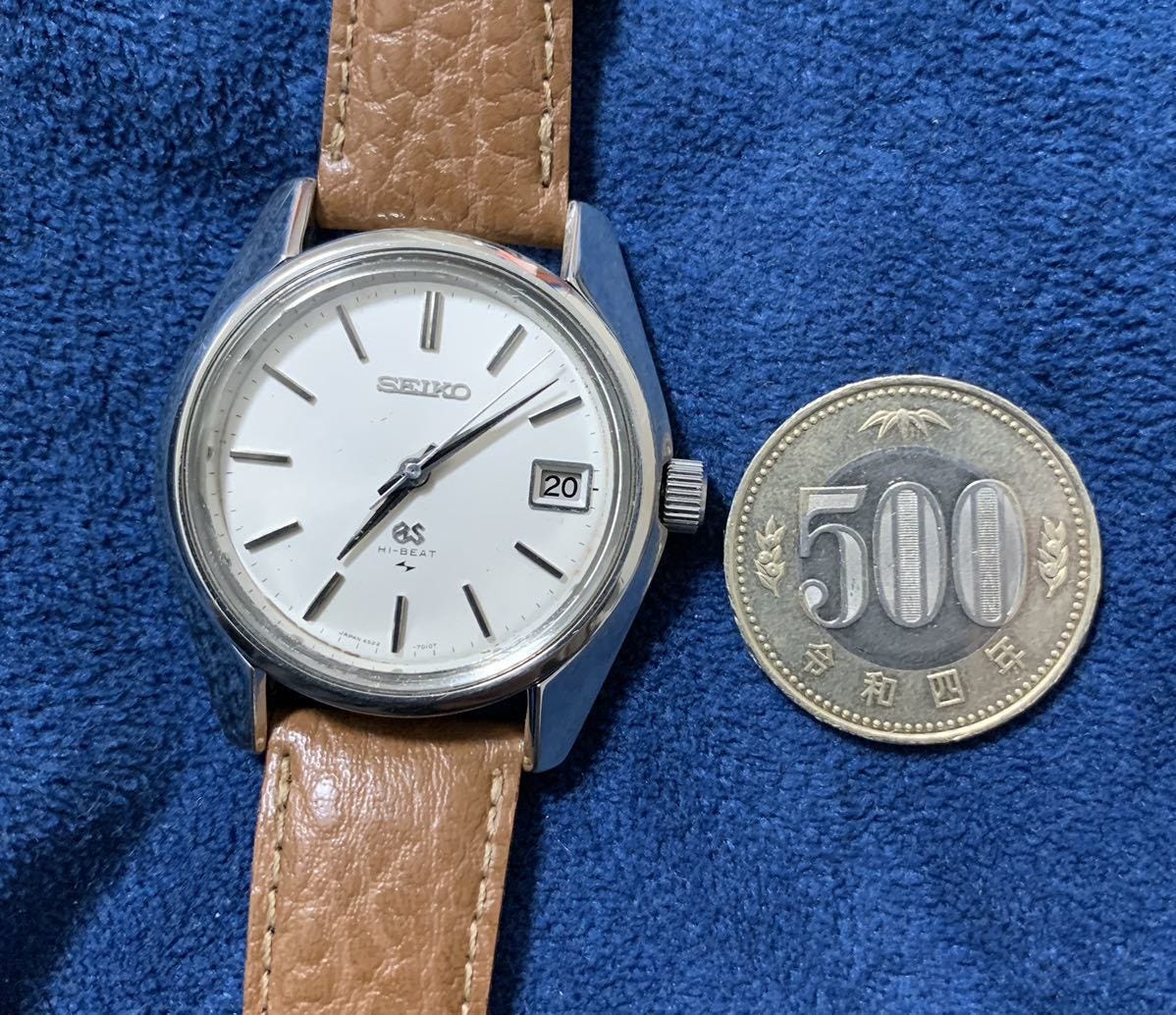










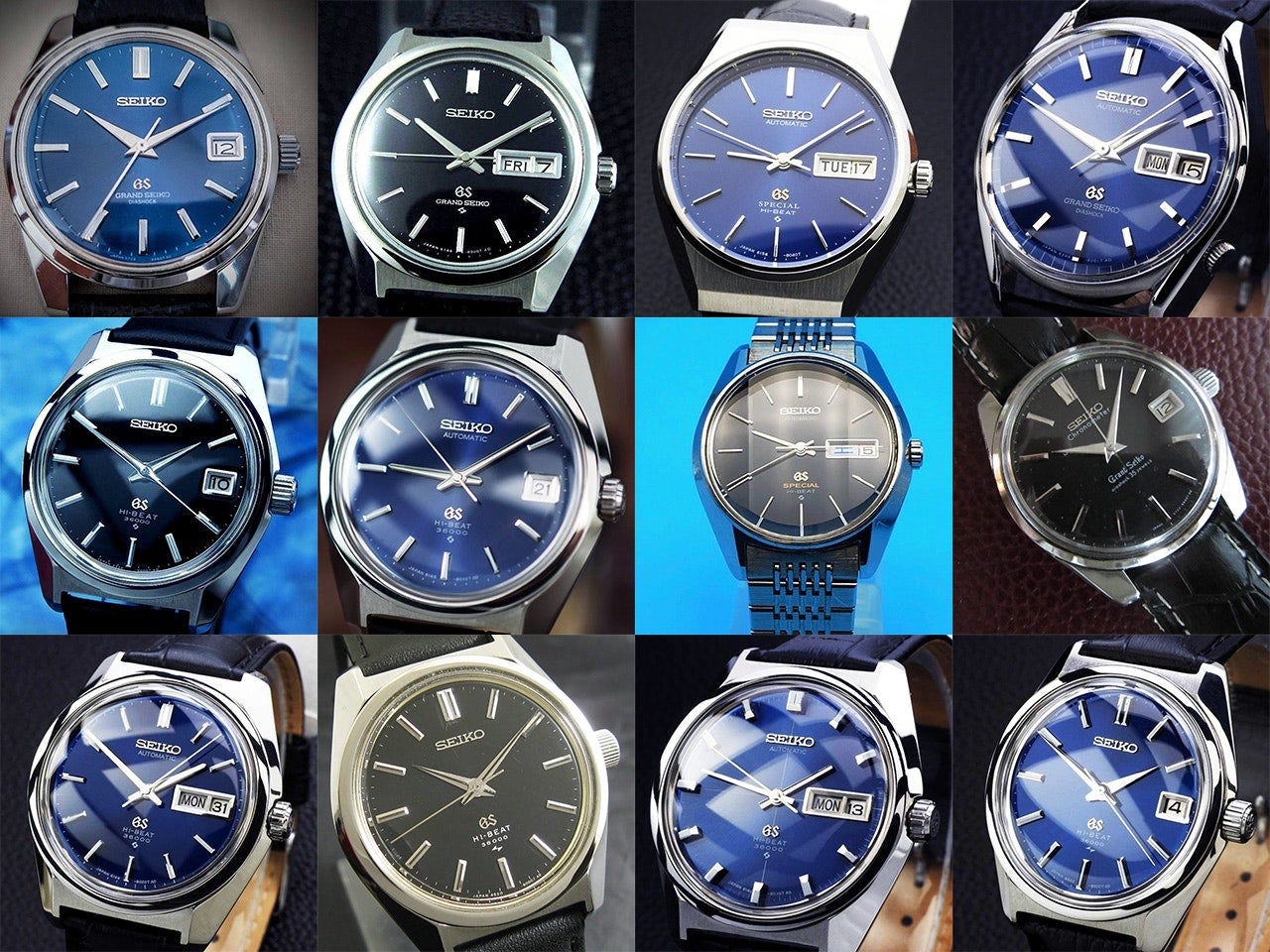
6185 8021 needs to be pristine
This one gets the twice over for educational purposes